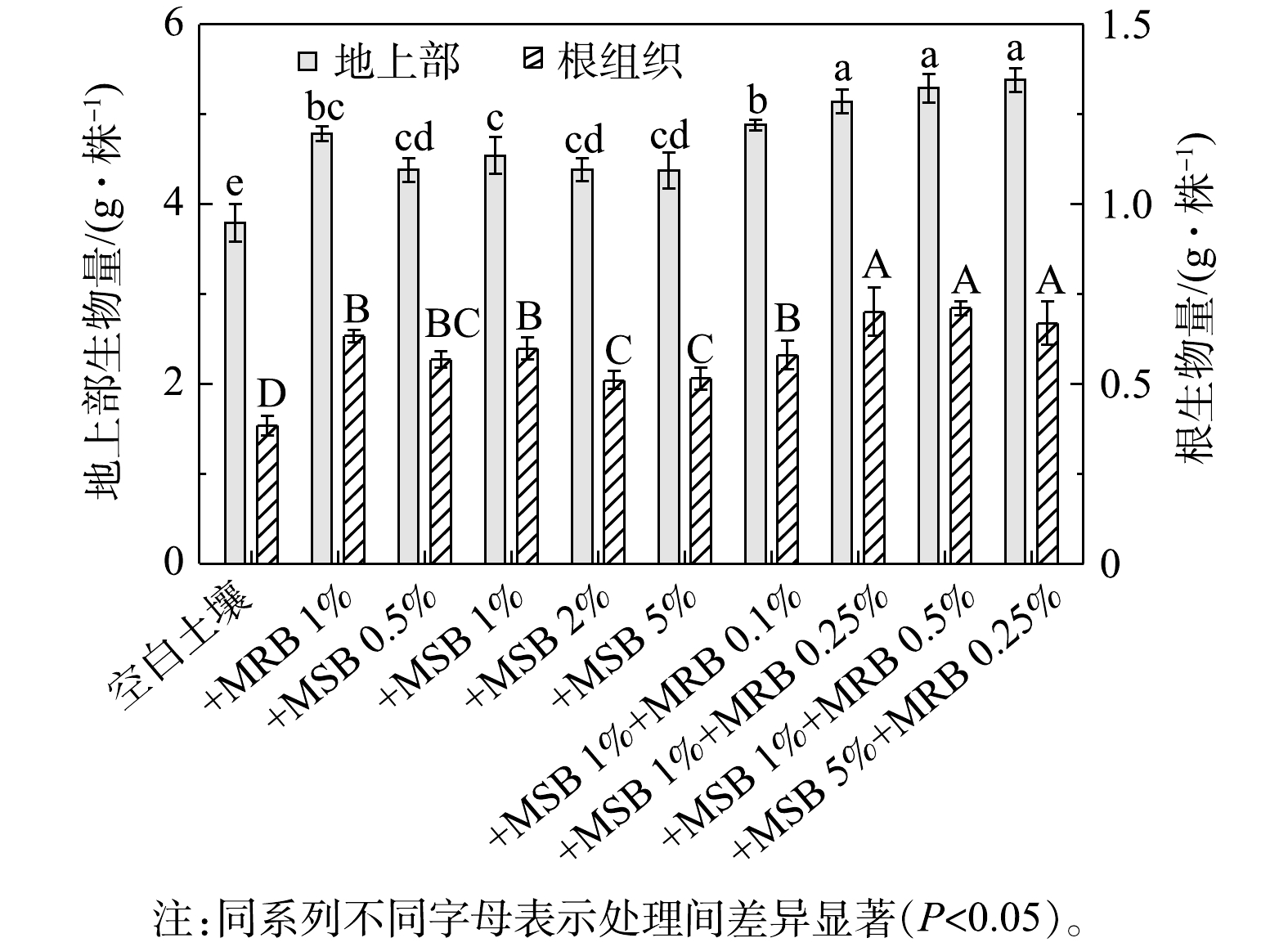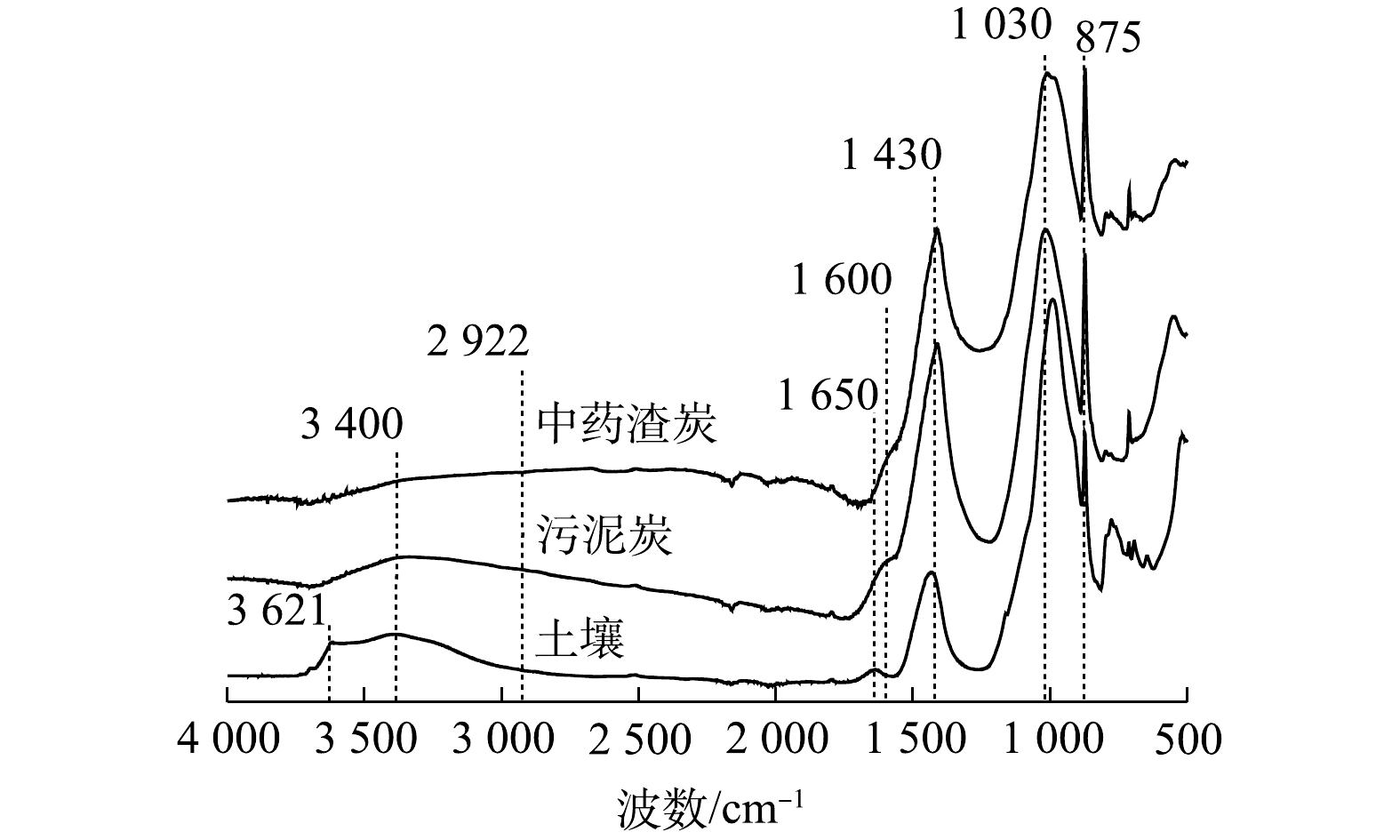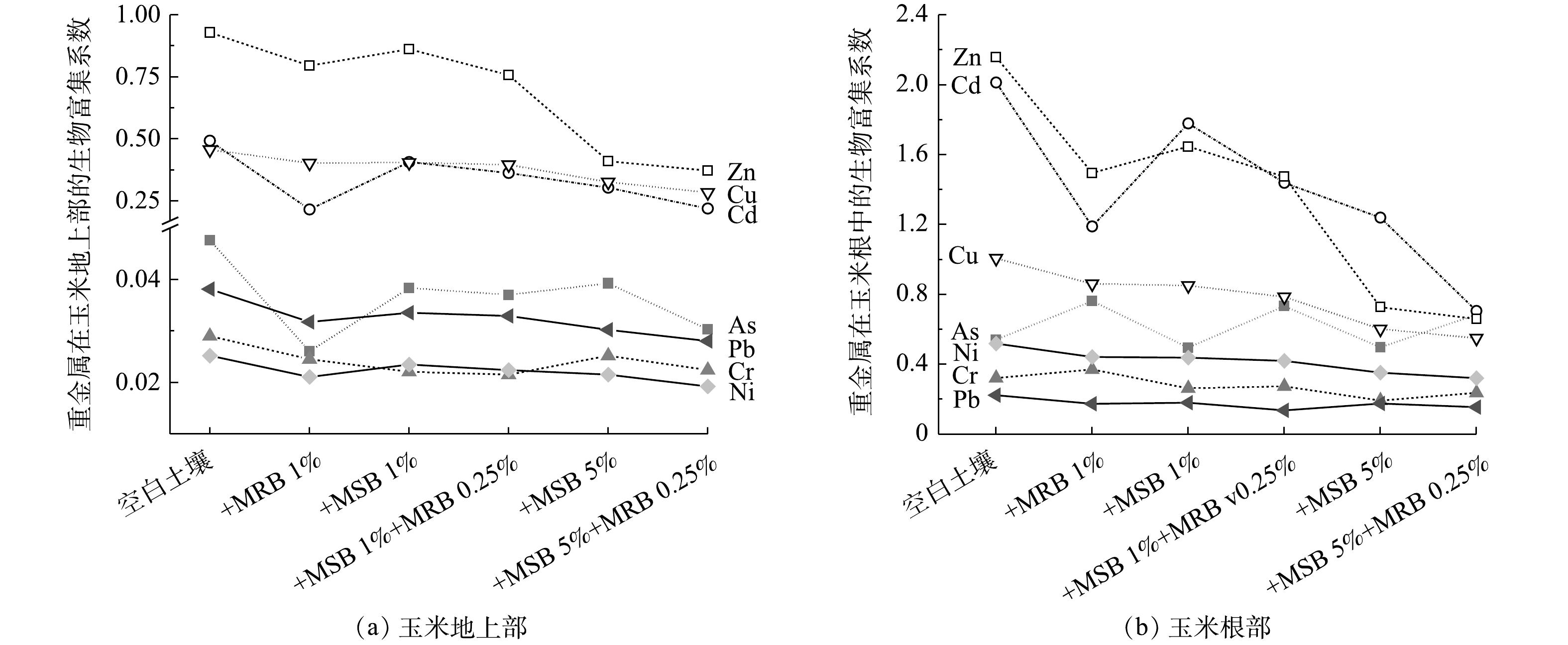-
随着我国城镇化进程的加快,以市政污泥为代表的有机固废排放量迅猛增长。2019年,我国污泥年产量已突破6 000×104 t[1]。市政污泥富含有机碳、氮、磷以及钙、铁、锌等植物生长所需的营养物质,具有良好的土地利用潜力[2-4]。但是,市政污泥中含有的重金属是制约其土地安全利用的最大风险因素[4-6]。通过高温热解可将市政污泥转化为性质稳定的生物炭。由于该技术具有可以减少残留体积、分解病原微生物及部分有机污染物、促进碳固定、钝化重金属等优点[6-9],而成为市政污泥资源化处理、降低其环境风险的推荐方法[6]。市政污泥热解产物污泥炭,作为一种典型的生物炭,可以增加土壤阳离子交换量、提高作物生物量及产量、减少温室气体排放等,其土地利用前景在近年来受到广泛关注[2, 5, 10]。然而,高温热解处理虽然降低了污泥炭中重金属有效态含量,但是重金属总浓度相对于原污泥通常显著富集[5, 9, 11]。目前,关于污泥炭进入土壤环境后其被钝化重金属的生物有效性和环境风险还缺乏了解,特别是关于污泥炭中被钝化重金属的生物有效性和植物暴露风险能否降低至可以忽略的水平尚不明确[12-15],限制了对其土地施用等资源化利用安全性的认识。
中药渣富含纤维素、木质素等有机成分,是一类未被充分利用的生物质资源。与市政污泥类似,安全、合理处置排放量逐年递增的中药渣已成为中药制药行业面临的迫切需求。中药渣经热解后产生丰富的含碳官能团,可以吸附、络合重金属,钝化其有效态组分[16-17]。因此,污泥炭配施中药渣炭有望进一步降低污泥炭中重金属环境风险[9, 13, 18]。截至目前,关于中药渣炭对污泥炭中重金属在受纳土壤中生物有效性的影响研究尚未见报道。
本研究选取市政污泥和中药渣等有机固废制备生物炭,通过盆栽植物吸收实验,系统开展2种有机固废生物炭进入土壤后其被钝化重金属生物有效性及其联合施用效应研究,重点探明施用有机固废生物炭影响下重金属化学有效性与植物吸收、传输重金属之间的响应关系、作用规律。通过该研究,将加深对市政污泥、中药渣等有机固废生物炭中重金属环境行为和风险的认识,为有机固废无害化处置、资源化利用提供参考。
全文HTML
-
市政污泥采自河北省某污水处理厂,中药渣为某制药厂莲花清瘟提取残留物。2种有机固废分别在工业热解炉内于500 ℃温度限氧热解45 min,自然冷却后,得到污泥炭(MSB)和中药渣炭(MRB)。将所得生物炭粉碎至0.25 mm(60目筛),备用。
供试土壤采自河北省望都县某处荒地土壤,为砂壤质褐土,经风干、粉碎后过2 mm尼龙筛。供试盆栽植物为玉米(Zea mays L., 郑单958)。
-
盆栽实验共设10个处理(表1),每个处理设3次重复。土壤、生物炭混匀后,每盆装(混合)土1.75 kg,每盆种植玉米4株,所有盆栽土壤均施入等量氮、磷、钾肥,即每盆0.76 g尿素、1.16 g 磷酸氢二铵、0.70 g 氯化钾。在温室中培养45 d后,分别收获玉米地上部分和根样品(包括残留在土壤中过筛得到的根样品);用去离子水冲洗干净,植物样品于70 ℃烘干至恒质量,称重,然后粉碎混匀,进行重金属含量分析。同时,收集盆栽土壤,分析施用有机固废生物炭对土壤理化性质及重金属有效性的影响。
-
土壤、生物炭中As、Hg、P总量采用HCl-HNO3消解液,其他重金属总量采用HCl-HNO3-HF-HClO4消解液,分别在微波消解仪(CEM Mars 6 Classic)进行消解提取[19];有效态重金属含量采用0.005 mol·L−1 DTPA、0.1 mol·L−1 三乙醇胺(TEA)和0.01 mol·L−1 CaCl2混合浸提液提取[20];有效态砷、磷含量采用0.5 mol·L−1 NaHCO3(pH=8.5)提取[21-22];植物样品(地上及根组织)采用HNO3-HClO4消解。上述消解/提取液中As、Hg含量采用原子荧光光谱测定,其他重金属含量采用ICP-MS测定,磷含量采用钼锑抗比色法测定。
土壤、生物炭中有机碳含量采用元素分析仪(Vario EL III, Elementar)测定;阳离子交换量(CEC)采用三氯化六氨合钴浸提、分光光度法测定[23];生物炭官能团组成采用傅里叶红外光谱仪(Nicolet 8700)分析测定。所有化学分析均设3次平行实验。在分析土壤、生物炭样品同时,分析空白样品和土壤标准物质GBW07401(GSS-1)作为平行样进行质量控制,标样回收率为93.8%~107.2%。
-
采用生物富集系数(bioconcentration factor,BCF)评价有机固废生物炭影响下受纳土壤中重金属的生物有效性及植物对其吸收、累积特征[24],见式(1)。
式中:Cp、Cs分别表示某重金属元素在玉米植株(地上、根)、土壤中的含量,μg·kg−1。BCF值越大,表明土壤中该重金属元素生物有效性越高。
采用Duncan多重比较法进行方差分析(差异显著性水平设为 P < 0.05),以检验不同处理间重金属有效态组分、植物吸收重金属量等的差异显著性。
1.1. 实验材料
1.2. 盆栽实验
1.3. 化学分析
1.4. 数据分析
-
供试土壤全氮及CEC水平相对较低、肥力较差;其重金属含量均低于《土壤环境质量 农用地土壤污染风险管控标准(试行)》(GB 15618-2018)[25]风险筛选值。污泥炭中除Cr外,其他重金属元素均不超过《生物炭基有机肥料》(NY/T 3618-2020)[26]关于As、Cd、Hg、Pb等重金属含量限值。由于目前《生物炭基有机肥料》(NY/T 3618-2020)[26]没有关于Cu、Ni、Zn等元素的限值,因此这3种元素含量参照《污泥农用污染物控制国家标准》(GB 4284-2018)[27]。污泥炭中Zn含量超过了GB 4284-2018标准[27]A级限值。中药渣炭中重金属含量均不超标(表2)。2种有机固废生物炭均富含氮、磷,特别是污泥炭中氮、磷含量高于供试土壤总氮、磷量30倍以上,具有良好的供肥潜力;而污泥炭的有机碳含量低于《生物炭基有机肥料》(NY/T 3618-2020)[26]关于碳质量分数20%的限值。
污泥炭及中药渣炭中除Zn以外其他重金属有效态含量与其在土壤中含量相当,污泥炭中Cu、Pb有效态含量甚至低于土壤(表3)。由于在生物炭样品中未检测到有效态Hg,后续不再对Hg的生物有效性进行分析。
-
有机固废生物炭施入土壤后,受纳土壤重金属总量虽然仍远低于《土壤环境质量 农用地土壤污染风险管控标准(试行)》(GB 15618-2018)[25]风险筛选值,但对受纳土壤中重金属有效性产生了复杂影响。例如,2种生物炭均显著增加了土壤有效态As、Zn含量(P < 0.05),同时显著降低了Cr、Pb有效态含量,对Cd、Cu、Ni有效态含量也有不同程度的降低趋势(表3)。中药渣炭配施污泥炭进一步降低了除As、Zn以外重金属的有效态含量。此外,施用2种生物炭均显著增加了土壤有效磷含量;但是对盆栽土壤pH影响不大,各处理土壤pH变异小于0.1 pH单位。
-
施用污泥炭显著促进了植物生长(P < 0.05);施用中药渣炭及其配施污泥炭也均显著促进了植物生长,特别是高施用量污泥炭配施中药渣炭处理对植物地上部及根组织生物量的促进作用尤为显著,相对于空白土壤增幅分别可达38%和72%(图1)。
-
污泥炭显著抑制了受纳土壤中玉米植株地上部对除Zn以外重金属的吸收,相对于空白土壤,吸收量降幅为3.2%~24.5%不等。其中,对As的吸收抑制达12%以上(P < 0.05) (表4)。施用污泥炭显著提高了玉米对Zn的吸收累积,吸收量与污泥炭施用量呈正相关关系(P < 0.05)。施用中药渣炭也增加了植株地上部对Zn的吸收,对其他重金属吸收呈现明显的抑制效应(P < 0.05)。相对于单施污泥炭,污泥炭配施中药渣炭处理可以进一步降低地上部对包括Zn在内的重金属的吸收。
相对于地上部,重金属在玉米根中富集明显,根中重金属浓度分别高于地上部1.7倍~21倍不等(表5)。与对地上部影响相似,施用污泥炭显著降低了玉米根对除Zn以外重金属的吸收,降幅为5%~30%;施用中药渣炭显著促进了As、Cr在植物根中的吸收、累积,而抑制其他重金属在玉米植株中的吸收累积。中药渣炭配施污泥炭同样显著了降低玉米根对除As、Cr以外重金属的累积。
2.1. 土壤、有机固废生物炭中重金属总量及有效态分布
2.2. 施用有机固废生物炭对土壤重金属有效态组分的影响
2.3. 有机固废生物炭对植物生长影响
2.4. 有机固废生物炭对植物吸收重金属影响
-
重金属有效性(availability)组分通常指土壤样品中利用温和提取剂可提取出来的、能够被生物吸收的部分[20];而生物有效性(bioavailability)组分是指生物体在特定环境介质中实际吸收、累积的部分[28]。有机固废生物炭施入土壤后,显著提高了土壤肥力,其中土壤有效磷含量和CEC分别增加了18%~100%和9.6%~18.8%,因而显著促进了植物生长,并对受纳土壤中重金属的有效性及植物吸收均产生了复杂的影响。例如,污泥炭虽然含有相对较高的Cr、Cu、Pb等重金属总量,但是施入土壤后反而降低了这些元素在土壤中的有效态含量(表3)。这可归因于污泥等有机固废经高温热解后产生大量有机含氧官能团(如1 650 cm−1附近含氧酰胺、羧基C=O及1 030 cm−1附近含氧芳香碳C—O吸收峰[11])、碳酸盐(875 cm−1为
CO2−3 吸附峰[12])(图2)、还原态硫及类似羟基磷灰石类化合物,这些官能团、化合物通过吸附、络合等作用不但可以钝化生物炭中重金属[5, 12, 29],还可以钝化土壤内源重金属有效态组分[2]。施用污泥炭及中药渣炭在提升土壤有机含氧官能团、有效磷含量的同时,也通过竞争结合位点作用促进了有效态砷的释放。施用污泥炭显著增加了土壤中Zn有效态含量,这与国内供水系统广泛使用的镀锌管给污泥等有机固废带来较高的Zn含量有关[11];而中药渣炭也含有相对较高的Zn,通过排查碳化过程中可能造成污染的环节,我们推测中药渣炭中的Zn可能来自原材料。污泥等有机固废生物炭中有效态Zn虽然大部分被钝化[8],但是其含量仍远高于土壤有效态Zn含量。在有机固废生物炭影响下,植物对Cd、Cu、Zn等重金属的吸收量与其在土壤中有效态含量呈显著正相关(P < 0.05);但对As、Cr、Ni、Pb等吸收量与其土壤有效态含量相关性有不同程度减弱,特别是As吸收量与其土壤有效态含量无相关关系(图3)。这种结果表明,有机固废生物炭不但直接影响重金属在受纳土壤中有效性,还可进一步影响其在受纳土壤中生物有效性。土壤重金属从其有效性组分到被生物体吸收的过程受重金属形态(有效性)、土壤性质、生物品种、重金属类型、环境共存离子等多种因素调控[12, 28]。有机固废生物炭进入土壤后,其含有的磷酸根、含氧有机官能团可以与As(砷酸根)竞争结合位点,促进土壤中As有效态含量释放,提高其在根中的吸收[30]。同时,磷酸根可以通过竞争植物体内转运载体而抑制As从根向地上部的传输,降低其在植物地上部的累积[10, 30-31]。土壤中Cr主要以正三价铬离子和正五价铬酸根形态存在[32],有机固废生物炭中磷酸根、硫酸根及含氧有机官能团也可以与铬酸根竞争吸收位点及植物体内转运载体。这些过程对As、Cr等在玉米植株中的吸收、传输过程产生深刻影响,并影响其有效态含量指标对植物吸收量的反馈。目前关于有机固废生物炭对其他重金属离子从土壤向植物根及地上部分传输影响的作用机制尚不清楚,有待进一步深入研究。
通过比较重金属在土壤-植物系统中BCF,可以看出植物对不同重金属吸收、富集能力差异很大。其中,Cd、Cu和Zn的BCF远高于其他重金属,部分处理中植物根Cd、Zn含量超过了土壤中水平(BCF>1)(图4)。在有机固废生物炭影响下,重金属在植物地上部以及除As、Cr以外其他重金属在根组织中的富集程度显著降低。在中药渣炭混合污泥炭影响下,包括Zn在内的重金属在植物中的BCF进一步降低,而且这种影响作用与重金属BCF呈显著正相关,即重金属在植物中BCF越高,生物炭的影响作用就越显著。这种结果表明,施用有机固废生物炭在通过吸附、络合等反应降低土壤重金属有效性的同时,生物炭中被钝化的重金属在短时间内并没有被活化,从而阻滞了重金属从土壤向植物迁移、传输,降低了重金属在土壤中的生物有效性和污染风险;不同重金属生物有效性对施用生物炭响应不同可能与重金属离子性质、以及对磷酸根、含氧有机碳吸附、络合反应差异有关。如Cd水合离子半径较大、不易被吸附钝化[33],因而其有效态组分占其总量比例较高,因而也易受生物炭调控;而Cu、Zn分别易与含氧羧基、磷酸盐结合[8]而被钝化。有机固废生物炭这种选择性抑制植物对某些重金属的吸收、传输影响可为选择合适的措施来调控重金属污染风险提供科学依据和技术参考。
-
1) 施用市政污泥、中药渣等有机固废生物炭显著降低了除Zn以外重金属的生物有效性,并抑制重金属从植物根部向地上部的传输,不同重金属对有机固废生物炭的阻滞效应响应不同,其中Cd、Cu、Zn受有机固废生物炭影响较为显著。
2) 中药渣炭联合污泥炭施用可以进一步钝化重金属,但存在促进植物根组织吸收As、Cr等污染物的风险。
3) 进入到土壤环境以后,有机固废生物炭中被钝化重金属生物有效性在短期内相对较低,其长期环境行为和风险研究亟待加强。






 下载:
下载:



 百度学术
百度学术



